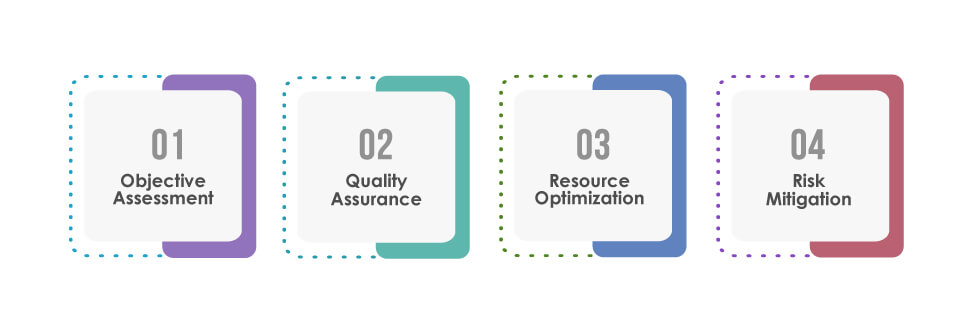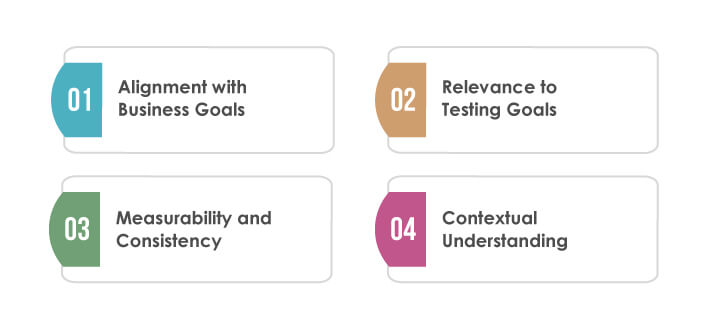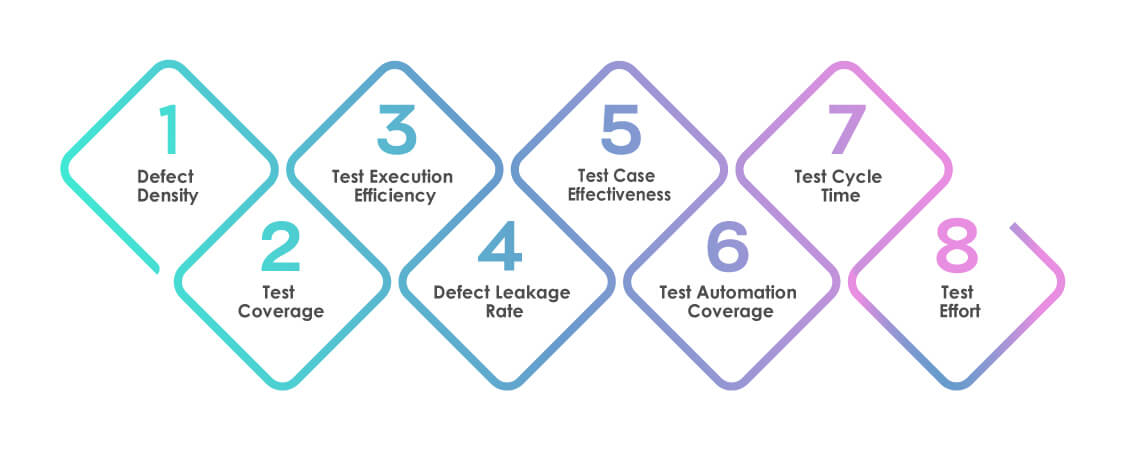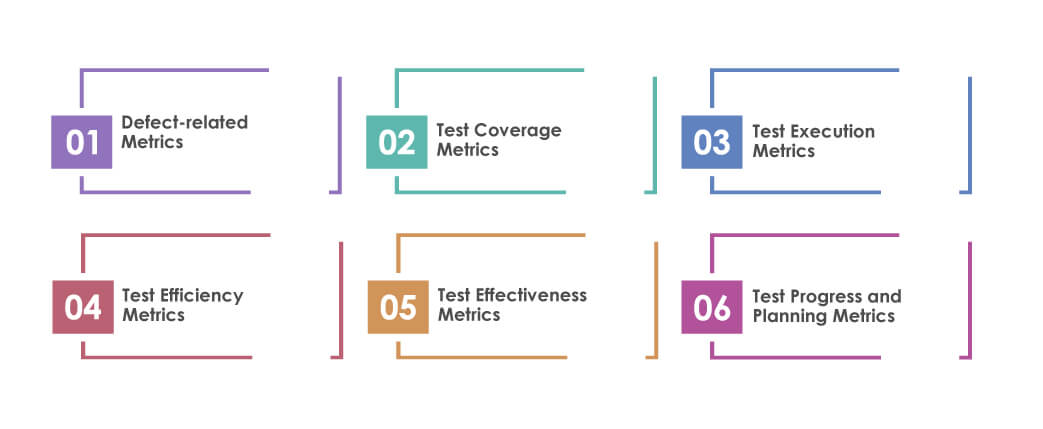Recommended Blogs
Why Every CTO Should Follow Software Testing Metrics?

Table of Contents:
- Introduction to Software Testing Metrics
- Why are Software Testing Metrics Important?
- Types of Test Metrics
- How to Choose the Right Test Metrics?
- Some Key Software Testing Metrics
- Conclusion
- How Can TestingXperts Help You with Software Testing?
In today’s rapidly evolving technological landscape, software testing plays a crucial role in ensuring software applications’ quality, reliability, and success. Chief Technology Officers (CTOs) need to adopt a data-driven approach to effectively monitor and improve the testing process.
This is where software testing metrics come into play. In this blog, we will explore the significance of software testing metrics for CTOs, discuss why they are essential, provide insights on choosing the right metrics, highlight some key software testing metrics, and conclude with an overview of how TestingXperts can assist CTOs in this endeavour.
Introduction to Software Testing Metrics
Software testing metrics are quantitative measurements used to assess the software testing process’s effectiveness, efficiency, and quality. These metrics provide objective data and insights into various aspects of testing, enabling stakeholders to make informed decisions, track progress, and drive continuous improvement. Software testing metrics help evaluate the testing efforts’ performance, identify improvement areas, and ensure that the software meets the desired quality standards.
Software testing metrics can encompass a wide range of measurements, including:
Defect-related Metrics
Defect density: The number of defects identified per unit of code or application.
Defect removal efficiency: The percentage of defects removed during the testing process.
Defect leakage rate: The percentage of defects found in production or post-release.
Test Coverage Metrics
Code coverage: The extent to which test cases exercise the source code.
Requirement coverage: The percentage of requirements covered by test cases.
Functional range: The degree to which the functional aspects of the software are tested.
Test Execution Metrics
Test case execution time: The time to execute a set of test cases.
Test case failure rate: The percentage of test cases that fail during execution.
Test environment stability: The availability and reliability of the test environment during execution.
Test Efficiency Metrics
Test effort: The amount of time, resources, and effort invested in testing.
Test productivity: The number of test cases executed, or defects found per unit of time or effort.
Test automation coverage: The percentage of test cases automated versus manual.
Test Effectiveness Metrics
Test case effectiveness: The ability of test cases to identify defects.
Test pass/fail ratio: The ratio of successful test cases to failed test cases.
Test cycle time: The time taken to complete a testing cycle or iteration.
Test Progress and Planning Metrics
Test completion status: The percentage of planned test activities that have been completed.
Test schedule variance: The deviation from the planned schedule for test execution.
Test case backlog: The number of pending or unexecuted test cases.
Why are Software Testing Metrics Important?

Software testing metrics are essential for evaluating the testing process’s effectiveness, efficiency, and quality. It provides valuable quantitative data that enables teams to make informed decisions, identify areas for improvement, and measure the success of their testing efforts. Organizations can optimize their testing strategies by leveraging software testing metrics, enhancing product quality, and ensuring a seamless user experience.
Software testing metrics are important for several reasons:
Objective Assessment
Software testing metrics provide an objective assessment of the testing process, enabling CTOs to evaluate their testing strategies’ effectiveness and identify improvement areas. Metrics offer tangible data that can be analyzed to make informed decisions and drive continuous improvement.
Quality Assurance
CTOs can gain visibility into the software quality being tested by tracking relevant metrics. Metrics such as defect density, defect leakage rate, and test coverage provide insights into the overall quality level and help ensure the software meets the desired standards.
Resource Optimization
Testing metrics help CTOs optimize resource allocation by identifying resource bottlenecks, inefficiency, or underutilization. By analyzing metrics related to test execution time, resource utilization, and defect distribution, CTOs can make informed decisions on resource allocation, ensuring optimal utilization and cost-effectiveness.
Risk Mitigation
Metrics play a vital role in risk assessment and mitigation. By monitoring metrics such as defect severity distribution, test coverage, and regression test effectiveness, CTOs can identify potential risks early on and take proactive measures to address them, reducing the likelihood of critical failures in production.
Types of Test Metrics
• Process Metrics: It improves the process efficiency of the SDLC (Software Development Life Cycle)
• Product Metrics: It deals with the quality of the software product
• Project Metrics: It measures the efficiency of a project team or any testing tools.
Considerations for Identifying Test Metrics:
• Target Audience: Determine who will use the metrics.
• Goal Definition: Clearly define the objectives of using metrics.
• Relevance to Project Needs: Introduce metrics that align with project requirements.
• Cost-Benefit Analysis: Assess the costs and benefits of each metric, considering the project lifecycle phase for maximum effectiveness.
Manual Test Metrics
Manual test metrics are divided into two categories:
• Base Metrics
• Calculated Metrics
Base metrics are the basic information gathered by Test Analysts during the creation and execution of test cases.
Calculated metrics are figures derived from this base data. Test managers often use calculated metrics for reporting testing progress and results.
Depending on the project or business model some of the important metrics are:
• Test case execution productivity metrics
• Test case preparation productivity metrics
• Defect metrics
• Defects by priority
• Defects by severity
• Defect slippage ratio
How to Choose the Right Test Metrics?

Selecting the appropriate software testing metrics guide is crucial to gain meaningful insights. Here are some key considerations when choosing test metrics:
Alignment with Business Goals
Test metrics should align with business goals and objectives. CTOs should identify metrics that reflect the desired outcomes and support strategic decision-making.
Relevance to Testing Goals
Metrics should directly address the specific goals of the testing process. Whether measuring test coverage, defect trends, or execution efficiency, the chosen metrics should provide actionable information to improve the testing process.
Measurability and Consistency
Metrics should be measurable and consistent over time. CTOs should select metrics that can be easily tracked, consistently measured and compared to establish trends and patterns.
Contextual Understanding
It is essential to understand the context and limitations of each metric. CTOs should consider their organization’s and industry’s needs to ensure that the chosen metrics provide meaningful insights into their context.
Some Key Software Testing Metrics

There are various software testing metrics that organizations can utilize to assess the effectiveness and quality of their testing efforts.
Here are some key software testing metrics:
Defect Density
It measures the number of defects identified in a specific unit of code or application. It helps gauge the quality level and identify areas that require additional attention. A high defect density may indicate poor code quality or inadequate testing coverage.
Test Coverage
It measures the extent to which the test suite has exercised the software under test. It helps determine testing adequacy and identifies areas requiring additional test cases. It can be measured in code, requirement, or functional coverage.
Test Execution Efficiency
This metric measures the efficiency of the test execution process, considering factors such as test execution time, test case failure rate, and test environment stability. It helps assess the effectiveness and efficiency of the testing process and identifies potential bottlenecks or areas for improvement.
Defect Leakage Rate
The defect leakage rate calculates the percentage of defects found in production or post-release. It helps assess the effectiveness of the testing process in identifying and preventing defects from reaching end-users. A low defect leakage rate indicates robust testing and better software quality.
Test Case Effectiveness
It measures the ability of test cases to identify defects. It helps evaluate the quality and adequacy of the test suite. Test case effectiveness can be measured by the number of defects found per test case or the percentage of test cases that identify defects.
Test Automation Coverage
It measures the extent to which test cases are automated versus executed manually. It helps assess the level of automation in the testing process and the efficiency gained through automation. A higher test automation coverage can lead to faster test execution and increased productivity.
Test Cycle Time
It measures the time to complete a testing cycle or iteration. It includes test planning, test execution, defect management, and reporting. Monitoring test cycle time helps identify potential delays or inefficiencies in the testing process.
Test Effort
It measures the time, resources, and effort invested in testing activities. It provides insights into the action required for testing and helps in resource planning and allocation. Test effort can be measured in terms of person-hours or person-days.
Conclusion
Software testing metrics are invaluable for CTOs to drive data-driven decision-making, enhance software quality, optimize resource allocation, and mitigate risks. By choosing the right metrics and regularly monitoring them, CTOs can gain valuable insights into the testing process, identify improvement areas, and align testing efforts with strategic goals. TestingXperts stands ready to assist CTOs in leveraging software testing metrics effectively to enhance software quality and ensure successful software projects.
How Can TestingXperts Help You with Software Testing?
TestingXperts, a leading software testing company, offers comprehensive expertise and services in software testing. With a team of experienced professionals, proven methodologies, and advanced testing tools, TestingXperts can assist CTOs in implementing effective software testing metrics, establishing robust testing processes, and achieving their quality objectives.
Why Choose TestingXperts for Software Testing?
Expertise and Experience
Our team consists of highly skilled and experienced software testing professionals who are well-versed in industry best practices, emerging technologies, and the latest trends in software testing. With a proven track record of delivering successful projects, we have the knowledge and expertise to cater to your specific testing needs.
Comprehensive Testing Solutions
We offer end-to-end software testing solutions that cover the entire testing lifecycle. From test strategy and planning to test execution and defect management, we have you covered. Our services include functional testing, performance testing, security testing, usability testing, and more. We have the capability to test applications across various domains and platforms.
Customized Approach
We understand that every organization and project is unique. That’s why we take a tailored approach to software testing. We work closely with you to understand your requirements, objectives, and constraints. Based on this understanding, we develop a customized testing strategy and roadmap that aligns with your business goals.
Advanced Tools and Technologies
To ensure efficient and effective testing, we leverage cutting-edge tools and technologies. Our team stays updated with the latest advancements in the testing landscape, allowing us to employ the most suitable tools and methodologies for your specific project. We aim to streamline the testing process and maximize productivity.
Quality Assurance and Risk Mitigation
We prioritize quality assurance and risk mitigation throughout the software testing lifecycle. Our rigorous testing methodologies and processes are designed to identify and address potential defects and vulnerabilities early on. By mitigating risks and ensuring software reliability, we help you deliver robust and secure software products to your customers.
Timely Delivery and Cost Efficiency
We understand the importance of timely delivery and cost efficiency in today’s competitive market. Our dedicated team works diligently to meet project deadlines while maintaining the highest standards of quality. We strive to optimize resources, minimize project costs, and provide you with exceptional value for your investment.
Take the next step towards enhancing your software quality and customer satisfaction. Contact us today to discuss your software testing requirements and discover how we can empower your organization with our industry-leading testing expertise.
Discover more
Stay Updated
Subscribe for more info

